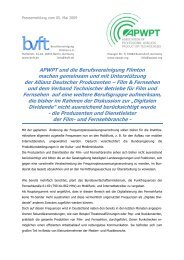Digital Dividend: Insights for spectrum decisions - ITU
Digital Dividend: Insights for spectrum decisions - ITU
Digital Dividend: Insights for spectrum decisions - ITU
- No tags were found...
Create successful ePaper yourself
Turn your PDF publications into a flip-book with our unique Google optimized e-Paper software.
<strong>Digital</strong> <strong>Dividend</strong>: <strong>Insights</strong> <strong>for</strong> <strong>spectrum</strong> <strong>decisions</strong>rooftop, fixed indoor, portable or mobile), the percentage of population to be covered, the qualityrequired, the technology used, the respective use of MFN and SFN.Since the VHF and UHF broadcasting bands are also allocated in a number of countries to services otherthan broadcasting, e.g. to aeronautical radionavigation, radio astronomy, fixed services, or used by PMSEapplications, two situations may occur:– protection of these services may reduce the size of the digital dividend (e.g. aeronauticalradionavigation and radio astronomy in some countries);– services need to be adapted to the new situation or re-allocated (e.g. PMSE applications inmany countries), which may entail additional costs.The size of the digital dividend will there<strong>for</strong>e vary from country to country. It may also be impacted by thesituation in adjacent countries, as a result of the need to avoid, or limit interference.Attempts have been made to determine the size of the digital dividend. Due to the multiplicity of thepossible choices in planning <strong>spectrum</strong> <strong>for</strong> broadcasting, and to the fact that many of these choices mayhave to be adjusted taking into account actual operational environment, this determination is in mostcases impossible to make ex-ante with any significant degree of accuracy.Rather than quantifying the digital dividend and trying to apportion it to the services involved, <strong>spectrum</strong>allocation <strong>decisions</strong> there<strong>for</strong>e have to rely on satisfying the requirements of these services in the mostappropriate way. Fortunately, technology has evolved rapidly in recent years and superseded any suchdeterminations.For example, in the case of fixed rooftop reception, the use of the latest technologies in terms ofmodulation and compression permits, through the deployment of four multiplexes of 8 MHz bandwidth,the delivery of up to 80 standard definition television programmes or up to 20 high definition televisionprogrammes, which is likely to satisfy the broadcasting requirements of most countries.Higher requirements may be satisfied through more intensive use of <strong>spectrum</strong>, by increased use of SFNand/or reduced frequency reuse distances between transmitters. This requires accepting both reducedinterference margins and additional constraints on transmitted signals, such as shaping of antennaradiation patterns. Both of these may translate into losses in the service areas of the transmitting sites.The use of additional gap-fillers may not be sufficient to recover these losses.More intensive use of the <strong>spectrum</strong> allocated to broadcasting will obviously reduce the amount of<strong>spectrum</strong> available <strong>for</strong> white space applications. Annex 2 of ECC Report 159 3 shows the results of studieson the amount of <strong>spectrum</strong> in the band 470 -790 MHz potentially available <strong>for</strong> white space devices in anumber of European countries (see also Chapter 7).2.5 Importance of the digital dividendThe essence of the digital dividend is to open the possibility of re-allocating a large part of the radio<strong>spectrum</strong>. Like any other <strong>spectrum</strong> allocation decision it is about allocating scarce resources. In this senseit is no different to what <strong>spectrum</strong> managers normally do. However the digital dividend has some specificswhich set it aside and makes it one of the most important <strong>spectrum</strong> <strong>decisions</strong> expected to make <strong>for</strong> manyyears to come.Be<strong>for</strong>e addressing the specific aspects of the digital dividend allocation, it is important to note that thedigital dividend is not only about <strong>spectrum</strong> efficiency gains. By definition of the digital dividend (seesection 2.1), the process is closely related to the introduction of digital terrestrial television. Thisintroduction of new digital television services will deliver other important benefits.3ECC Report 159 Technical and operational requirements <strong>for</strong> the possible operation of cognitive radio systems in the‘white spaces’ of the frequency band 470 – 790 MHz, January 2011.4






